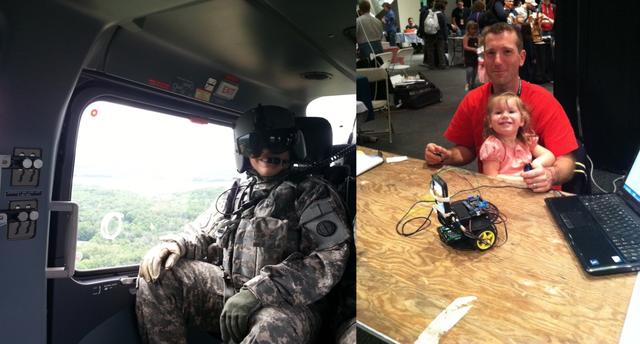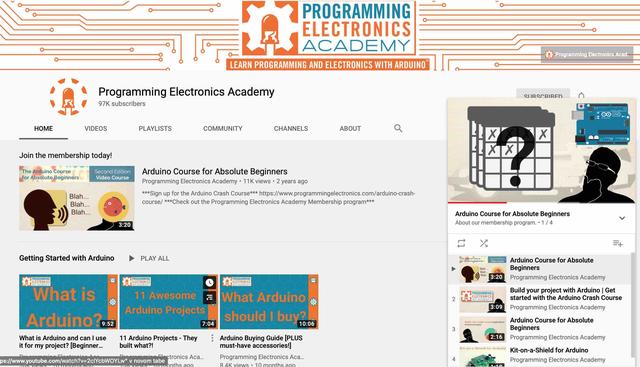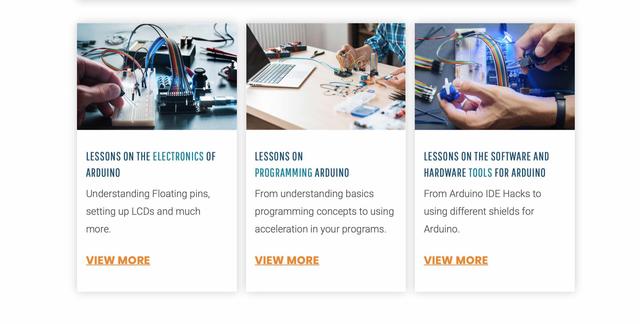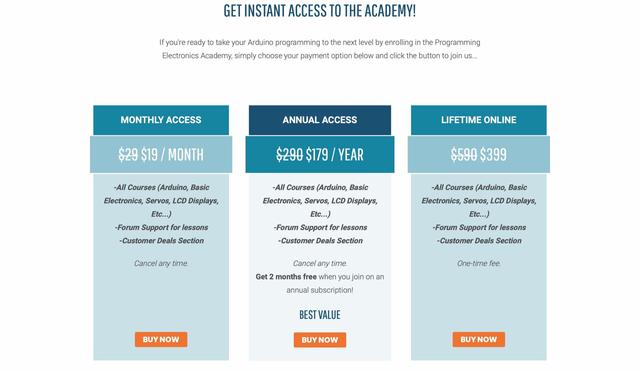Since 2013, Michael Cheich has been teaching people how to program robots, thermostats and motion detectors via the Arduino prototyping platform. You could say he’s written the book on it, his Arduino Course for Absolute Beginners and is the founder of the ProgrammingElectronicsAcademy.com.
Originally a skilled amateur Arduino programmer, Cheich originally just wanted to share his knowledge and to help Arduino find a larger audience:
It’s a really common micro-controller for people who are into hobby electronics for the past 20 to 10 years. Arduino has started in Italy and has allowed hobbyists to do some really neat things with micro-controllers which are like very small computers. You can find micro-controllers in everything like refrigerators or in a car and they’re very inexpensive but you can programme them to do all types of really cool stuff. Arduino just really allowed to the electronic hobbyists out there to do amazing stuff that would have been much more difficult before but so they still have to learn how to programme.
Here’s the story of how Cheich built ProgrammingElectronicsAcademy.com
Cheich started out as an undergraduate student of Neuroscience at The Ohio State University where he took a part in a research project, where he was responsible for building neurophysiology rigs with which to capture the inner workings of the moth brain. After university, he attended military school. As a Captain and Flight Company Platoon Leader, Michael flew jets for twenty years.
Even while he was flying, Cheich kept working at his hobby programming. When he retired from the Air Force, he decided to get serious about sharing his knowledge.

Left: Michael inside an Air Force plane︱Right: Teaching new programmers how to program robots
In 2013 Cheich was looking for a cost-free solution to share his ideas with an audience:
I had started putting some videos on YouTube about my programming electronics hobby and I started getting really nice feedback from people on YouTube which doesn’t happen often. On YouTube, people are usually pretty snarky, so it has left me astonished.
People are watching videos and leaving nice comments? Maybe there’s some opportunity here.
He started a YouTube channel which has grown to almost 100,000 subscribers. Despite his large contingent of regular subscribers, Michael found engagement in YouTube to be for the most part fleeting and casual.
 Programming Electronics Academy YouTube channel
Programming Electronics Academy YouTube channel
Keen to interact more with his audience, Cheich started to think about a channel which, unlike YouTube, wouldn’t distract his subscribers from his original content:
I thought – well, let me try writing a book about this stuff, so I did that and I’ve sold some. And I thought wow – maybe I could make some money doing this. And then I thought that if the videos worked, I should try producing more of them. I took my shot at it making some videos and then selling them. I even actually sold the videos on flash drives as a course basically for a while.
The content of the Arduino Course for Absolute Beginners book serves as the base for its video version – the video-courses in Cheich’s online learning site, the PEA (ProgrammingElectronicsAcademy.com):
What I did for the book was what I felt like I needed the most when I started to learn electronics programming.
What is important when you’re starting out on something very technical is that you need to get the simplest things down pat: you have to know them really really well. And when you know these most fundamental things well, it allows you to more complicated things much more quickly later on.
A lot of people want to start a project and they want to start with complicated things, but since they don’t know the basics they’re struggling to do this complicated thing because every time they need to do the simple thing it takes them a long time.
A sports analogy would be in basketball – you need to know how to pass, you need to know how to catch the ball and you need to know how to shoot. If you can do those basic things really well then you can start to learn more advanced team or group moves.
Cheich started to feel limited by the drawbacks of selling physical copies of his courses. He noticed that tools were arriving to make it possible for independent publishers to deliver their content directly online:
It seemed as though the industry was moving towards, there has been a lot of training websites jumping up on the internet, so I thought of it as a model that I could try – doing a paid membership type of programme and so that’s what I’ve set up.
What I’ve focused on previously in the book, became my mission with the new website – the concept and content is very much about the fundamental stuff that is important to know if you’re getting started with Arduino programming.

An overview of basic lesson topics at Programming Electronics Academy
Rather than putting out weekly clickbait videos to pump subscriber numbers, Cheich’s single-minded goal was to create a high quality and structured video-course library:
There were some other people doing it before but I think they were more just kind of throwing videos up on YouTube that were okay but I was trying to set myself apart, try to increase the production quality, the video and then to be very organised and intentional about how the material is going to be presented, so that when people would watch the video they wouldn’t think: ‘oh, this is just another video tutorial on the internet’ but instead they would think: ‘oh wow, this is part of a very organised curriculum’.
With success, over time Cheich has built out a team:
At first it was just me, now I have a small team that I work with. Some people are writing material and others help with producing the videos. I still do lot of the voice, although I try to outsource that a little bit too. The video is not a talking heads video, it’s more about seeing things moving around, there’s a lot of movement. The idea is to teach programming but stay engaging.
When it came time to set up his e-learning site in 2013, Cheich decided to build on WordPress:
It was a recommendation. At the time, I was forming the company and getting the website set up and I was listening to different podcasts about getting into business online. It seemed to be the consensus was – go WordPress. It seemed like a no-brainer, especially when you’re starting out and your budget is like zero, it made perfect sense.
For his first video series, Cheich of course chose the Arduino programming course to be the product upon which the platform is built around.

Build your project with Arduino | Get started with the Arduino Crash Course
Seeking the ideal video player for e-learning
The Progamming Electonics Academy website was originally built from a set of ONTRAPages with a special WP Courseware plugin for online courses, which allowed him to build landing pages with an integrated membership site. Initially, Cheich sold his courses separately but decided to move to a membership model with login on a dedicated subdomain. The courses are now bundled in a single membership, often bought by organisations in large multi-seat packages.

The currently available membership bundles
Cheich had been hosting his videos privately on Vimeo but wanted an unbranded player with more advanced e-learning features. For a long time he couldn’t find the right player:
I didn’t come across FV Player immediately and when I saw the other video services I thought ‘maybe I can’t afford this’. The other services just seemed a little different, almost like they only want to host your videos and I was like – well, I love Vimeo and I can’t just go away from Vimeo, it doesn’t make any sense. And I wanna say that embedding videos with other services often wasn’t easy nor was it necessarily WordPress friendly.
That changed the day Cheich came across the FV Player with its Interactive Video Transcript feature:
I can put it down to an exact instant. I found a video and below that video I saw an interactive video transcript and it blew me away. I had never seen interactive video transcripts before and right away I thought – this is amazing! If somebody could watch a video, see the words at the same time and search the text, I want my students to have this.
Because when you’re learning something new, you rarely watch a technical video once. It’s often something you have to watch multiple times, you have to kind of refer back to, especially when you’re new, there might be like this one little piece that you not sure you quite got and so it’s so hard to kind of move within the video and you try to find that specific spot. I call it scrubbing a video, when you take the ‘play’ thing and you try to find it. It’s very difficult and essentially what all my customers had to do for the longest time.
With so many videos already posted to Vimeo, Cheich didn’t want to contemplate moving video platforms:
We host with Vimeo, we’ve hosted our private videos with Vimeo for the longest time, forever essentially and that’s what they would have to do, so when I saw an interactive video transcript I said ‘okay, I’ve got to get this figured out to work with Vimeo’.
Finally he found a player with interactive video transcripts which works perfectly with Vimeo-hosted videos:
I’m so glad that I’ve found the extremely well-priced FV Player with it’s Interactive Video Transcript which is like four times better than the one that I’ve initially seen. The one I saw couldn’t search for words and it wouldn’t move you to a specific point in the video, so for me it was hands-down. Once I’ve found FV Player, I was like – this is my choice. I’ve been using FV Player now for two or three years.
FV Player is a truly platform agnostic video player, by design without its own hosting service. Whether you host your videos at Vimeo, YouTube, AWS Cloudront, S3, KeyCDN, BunnyCDN, DaCast, Akamai, Cloudflare, Stackpath or even on your own server, FV Player works with any of these services or even three or four of them at the same time.
The Interactive Transcript
As well as Vimeo hosting compatibility, it was very important to Cheich that his player play back smoothly across all platforms, Windows, Mac, tablet, iOS, Android:
The first and the biggest of my worries was that when I went to start using FV Player, I was afraid that it was only gonna work for some people. Vimeo works pretty much across the board. I mean, the player has got some problems, but generally it would play for people, regardless of the browser they’re on. You know, I had that going for me. I was a little afraid in the beginning that the FV Player would somehow be restricted by the browsers out there. Luckily, didn’t have that issue at all and I’m very pleased with that.
Behind the scenes, Foliovision keeps a full room full of hardware devices updated to the latest versions of each OS immediately to run full compatibility tests immediately on release against the full set of FV Player functionality.
How Adding Closed Captions/Subtitles with Interactive Video Transcripts to the same video helps students learn faster
While the Interactive Video Transcript helps make it easier for students to navigate a lesson, sometimes direct subtitles can help students whose native language is not English follow a course better:
The people who are on board with us come from all around the world, although we have mostly English speakers. This was one thing I really liked about the Interactive Video Transcript – we do get people who are not native English speakers and the transcript is important for non-native English speakers, especially if they don’t have strong English skills and so having these words displayed is a good thing.
Enabled Closed Captions in every video help users to memorise the information
FV Player’s AB Loop Helps Students with the tough sections
The AB Loop is another invaluable feature. On one hand, it helps learners who can select a specific part of the lesson to watch over and over until they master the topic. It’s even more effective with the speed buttons which allow users to re-watch the part and thoroughly follow anything visually happening in the lesson. On the other hand, it is one of the key features for online courses and educational business:
I like the repeat AB Loop feature very much. I think it’s pretty neat that you can kind of like close in on a specific piece and have it repeat on a loop.
The AB Loop can replay any specific part of the lesson
Picking up right where you left off: Video Position Saving
The Video Position Saving function makes it a lot easier for learners to have a break and return to the video lesson later where they left of, without losing track of their progress:
Maybe even more important than the Interactive Video Transcript is video position saving: if somebody watches the video, the next time they watch the video they go to where they left off – that’s a huge benefit. Most videos, you watch a thing on Vimeo or something and it doesn’t pick up necessarily where you left off, it doesn’t really do that so well, so I have found that with FV Player, it seems to do that really well. It’s very easy, ‘set it and forget it’ functionality.
Course navigation video helps students to use the FV Player features
FV Player Support and Customisation
When Cheich needed tweaking of the player’s functionality, he counted on technical support from the FV Forums:
Foliovision’s support team helped me solve issues with transcript positioning when I needed help. I have found the forum to be pretty responsive. But often I don’t need to ask for help. When I’ve had to search through it in the past, I almost always find somebody who’s already brought up my question and there’s already an answer there.
Sales and Retention
ProgrammingElectronicsAcademy.com keeps on growing. Cheich has worked hard on student retention: academy keeps growing steadily with the FV Player:
It works well. It’s still growing, it’s been a part time gig for me for a while, it’s not always been my full-time thing. I kind of go into and out of it but yes, it’s been good. I think the most important part is just working on retention, making sure people stay around and continually producing value so people do stay around when they see the value in what they’re paying for because retention is huge for the bottom line.
FV Player has helped Cheich keep his academy members happy:
I’ve got a lot of positive feedback from members on the FV Player. So, people who are with me from before I implemented the player, they definitely like it. People who are coming to me now that’s all they know but they’re very impressed by the player. It has an important function on the website.
Even when Cheich is watching videos on other platforms he misses FV Player:
I have some memberships as a subscriber. Anytime I’m using a video player on a technical video on a platform different than my own and don’t have the features there that I have on my website it kind of annoys me. I wanna be able to search for a word and I can’t even do that here, like give me a break. Part of me is a little boggled that the functionality isn’t more developed. I guess, now that I used the technology I couldn’t go back to anything else. It’s sort of like a priority to me now. Most publishers don’t seem to realise how much the advanced features of a player like FV Player can benefit their students.
Only recently, Cheich received a few warm words of satisfaction from a member interacting with the FV Player:
I decided to purchase online because of the feature rich video player. Love the speed changer and text follow along.
Besides Arduino, Cheich would like to add new platforms to his courses and reach out to a wider audience:
What we’re going trying to do is expand from Arduino and introduce some other platforms to increase the potential audience we could reach. To do that we have to find other experts to produce high quality content on the new programming platforms.
Check out some of the cool projects by the academy members programmed with Arduino, such as this Automated Plant Watering project.
References
Tune in and listen to a few episodes from the Programming Electronics Academy podcast series or follow PEA on their Facebook page.
For more details linked to FV Products visit:
- Interactive Video Transcript
- HLS Stream
- AB Loop
- User AB Loop
- New AB Loop appearance
- Video Position Saving

Chiara Rendeková
Chiara was born and raised in the neighbourhood of Petržalka in Bratislava. Besides studying Marketing Communication at Comenius University, she happens to be an observer, mostly through the lens of a camera.



Leave a Reply